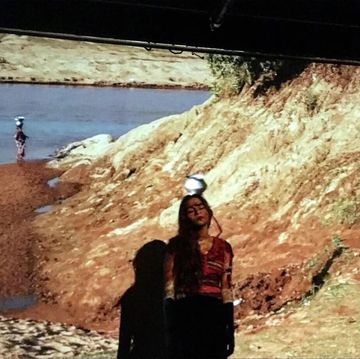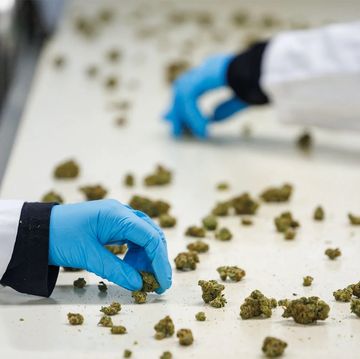Dan Abbott remembers free diving off the Sonoma Coast for abalone in 1987 when he was just 14 years old. Swimming through schools of fish of all colors and sizes and floating effortlessly in a kaleidoscope of light poking through a kelp canopy was “like flying through a redwood forest,” he recalls. Abbott, the Kelp Forest Program director at Reef Check Foundation, remembers the feeling of that moment to this day: “There was life everywhere, and you were just kind of in the middle of it all.”
This essay was adapted from the Alta newsletter, delivered every Thursday.
SIGN UP
Like forests on land, kelp forests feed, protect, and support thousands of species. Like coral reefs, kelp forests help reduce beach erosion by absorbing waves before they get to shore. Kelp also absorbs carbon through photosynthesis at a rate 20 times higher per acre than land forests do, capturing an estimated 1 billion to 10 billion tons of carbon dioxide per year.
But due to a 2014 marine heat wave, 95 percent of kelp—which needs nutrient-rich cold water to survive—has been decimated in Mendocino and Sonoma Counties and their surrounding areas, leaving the underwater terrain much less colorful.
“Those kelp forests are the home for all the snails and fish and all kinds of stars and crabs, and if there is zero kelp, they’re not going to be able to survive either,” says Laura Rogers-Bennett, a senior environmental scientist at the Bodega Marine Laboratory of UC Davis. “It’s devastating for the biodiversity of our nearshore kelp forests if they’re completely absent.”
Around the same time as the marine heat wave, a brutal virus called sea star wasting disease killed off a major predator to purple sea urchins, which graze on kelp. Because sea urchins can survive for long periods without kelp to feed on—albeit in a starved, zombie-like state—their populations have spiraled out of control. They now carpet ocean floors in regions called sea urchin barrens.
A host of solutions has been proposed to restore the ecosystem to equilibrium, from breeding sea stars in the lab to be reintroduced as urchin predators to using divers like Abbott to manually cull urchins. One idea involves reintroducing another voracious purple sea urchin predator into the system: the southern sea otter.
“Sea otters are a keystone species,” says Frances Gulland, of the Marine Mammal Commission. “They are key to maintaining healthy kelp forests.”
Sea otters consume 25 percent of their body weight per day. In a healthy kelp forest, otters eat enough urchins so that they don’t overpopulate and overgraze the kelp, says Colleen Young, a sea otter biologist with Santa Cruz’s Wildlife Veterinary Care and Research Center, run by the California Department of Fish and Wildlife’s Office of Spill Prevention and Response. In exchange for keeping the kelp healthy, otters wrap themselves in its leafy canopies to keep from floating away while sleeping.
When otters are contributing to a functioning ecosystem, it can have beneficially cascading effects. In a 2012 study, researchers posited that the presence of sea otters in an area stretching from Vancouver Island to the western edge of the Aleutian Islands in Alaska would store between 4.4 million to 8.7 million tons of carbon. The presence of otters, with their voracious appetite for clams and other invertebrates, has also been shown to increase the genetic diversity of seagrass, which is critical for its survival in changing climatic conditions.
Southern sea otters historically ranged from Mexico to Oregon. After near extinction caused by the colonial fur trade, a small population of otters was discovered off the coast of Big Sur in the early 1900s. With the help of protective policies, that raft of otters (on land, a group of otters is called a romp) has expanded to over 3,000. However, the population has declined over the past five years, with most otters living off the coasts of Central California, Young says.
Bringing southern sea otters north could be risky. Economically, the commercial fishing industry has had resistance to otters on the basis that the top predators are competition for valuable species like Dungeness crabs and abalone, despite the fact that otters have been shown to improve ocean health, creating more fish for everyone. In a 2020 analysis of the economic impact of reintroducing sea otters, researchers found that money made from ecotourism and carbon capture would outweigh potential economic losses to fisheries.
Geographically, shipping routes and other human developments have prevented southern sea otters from naturally returning to their historical range, Gulland says. Relocating otters to a new area could introduce new risks, like shark bites or regional diseases, according to Young. As it stands, along their periphery ranges, more and more otters are dying from shark bites, she says.
Prior to the Exxon Valdez oil spill in 1989, 140 sea otters were moved to San Nicolas Island to protect the species in case of another spill. Shark bites weren’t the major threat there, but many otters swam back, and the translocation was initially deemed a failure. Sea otters have a high site fidelity and like to go back to the same place, Young explains. However, enough stayed on San Nicolas Island to grow a colony of 114 otters as of 2020.
A 2019 study projected that as many as 6,000 sea otters could thrive in the San Francisco Bay Area, feeding on crabs in the local estuaries. Farther north, the Elakha Alliance is determining how feasible it would be to return sea otters back to Oregon’s coast.
But if otters are eating crab and other creatures over urchins, it’s unclear how much relocating them would do to restore kelp. A study published last year found that sea otters tended to select healthy urchins or other invertebrates over vacant purple sea urchins, which have little nutritional value. On the other hand, a prior study, in the Aleutian Islands sea urchin barrens, found that sea otters reintroduced to regions with presumably starved-out sea urchins did consume them in the absence of other options, says the former study’s author, Joshua G. Smith, a marine ecologist at UC Santa Cruz.
Although kelp is nearly entirely depleted northward, there are still patchy mosaics of kelp forests that have survived in Central California, Smith says. “Otters are fundamentally important for this mosaic and are so important in terms of why we still have remnant patches of kelp,” he says.
To save this complex ecosystem, fishermen, in partnership with Abbott’s team at Reef Check, have removed more than 26,000 pounds of purple sea urchins in a pilot program in Mendocino County, but it remains to be seen if that’s enough for kelp to regrow. All the while, heat waves like the one in 2014 are likely to increase in frequency with global warming and threaten to wipe out any progress that has been made. In the lab, sea stars have been successfully bred, but it’s unclear how they’ll fare when reintroduced into the water, says Rogers-Bennett, of UC Davis.
“I often talk about how if 95 percent of the redwood trees in Northern California disappeared in one year, there would be a lot of resources thrown at the problem,” Rogers-Bennett says. “Thinking about how we bring the kelp forests back, I think that’s the level of attention we’re going to need.”
With no silver bullet solution, it may be time to send in the otters.•
Elizabeth Hlavinka covers health, climate, and those most vulnerable to their respective crises.












